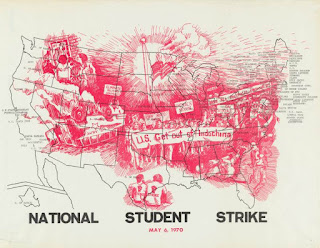“The
national student strike [of May 1970] was unprecedented in its scale and is an
inspirational testament to the power of young people to disrupt politics at a
national level and force their concerns to be acknowledged.“
Mapping American
Social Movements Project, University of Washington (map link here)
The 50th anniversaries of Kent State, Jackson
State and the National Student Strike that began on May 1, 1970, are the primary
focus of the Vietnam Peace Commemoration Committee work in 2020.
VPCC is assisting program on April 3-4 and May 14-15 at
Jackson State. We will bring to Kent
State on May 1 the personal experience of committee member Frank Joyce of how embattled North Vietnamese
villagers reacted to the Ohio deaths.
The University of Washington has interactively mapped and
analyzed 883 universities, colleges and high schools involved in the strike https://depts.washington.edu/moves/antiwar_may1970.shtml
Our challenge and opportunity is how to stimulate observances to honor history
and offer lessons for current movements at no less than one in ten of the locations
nationwide that forcefully protested the expansion of the war into Cambodia.
In some places there was a peaceful rally; in others, a
literal strike from classes and business as usual. Faculty and Administration could have been
big supporters or tried to stop it. At 30
schools frustration at Nixon prolonging and expanding the war was expressed by attacks
on ROTC buildings, reputedly in some instances led by angry veterans. High schools as well as universities were
affected. Some schools created a peace
curriculum; others did not return to class for the semester.
Never in US history has there been such a powerful diverse
national student movement. Its example
should serve the next crisis created by a mass shooting, police excesses or
military adventurism in Iran or Venezuela.
Ball State University in Indiana offers a great example to
how a school can be organized to learn from its experience with the 1969
Moratorium. Their program was more than
a year in preparation, and involved alumni, community members and current
students and faculty. (https://sites.bsu.edu/vmc50/livestream/)
However, with even just a month of preparation, people and
resources can be mobilized that will catch the imagination of former and
current activists, local educational and historical institutions, and their
supporters.
Here are a few suggestions about how to proceed:
1) Go to the interactive map produced by the University of Washington and identify which of the 883 schools were in your area https://depts.washington.edu/moves/antiwar_may1970.shtml
2) Dig deeper by an on-line search for “1970 Student Strike” plus the name of each of those schools.
3) With this knowledge, introduce yourself to the persons responsible for the school’s archives and history. Ask if they can provide additional documentation and visual resources. Invite them to working with you to create a public event and/or exhibit during the anniversary period.
4) Identify organizations, institutions and individuals mentioned in press coverage that are still present and willing to discuss their experience. Student governments and campus ministries could have their own records or oral traditions, and may be prepared to compare response then to the way issues like environment, gun violence and endless war are addressed now.
5) Ask local historians and museums sponsored by your city, county or state to participate.
6) Look at newspaper, radio and TV archives. Invite them to bring their coverage to a public presentation.
7) Keep us informed so your ideas can inspire others. Write to director@ffrd.org or use the comment form below.
1



No comments:
Post a Comment